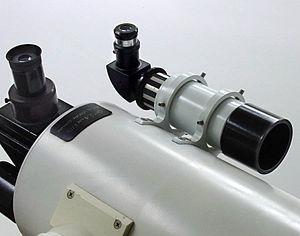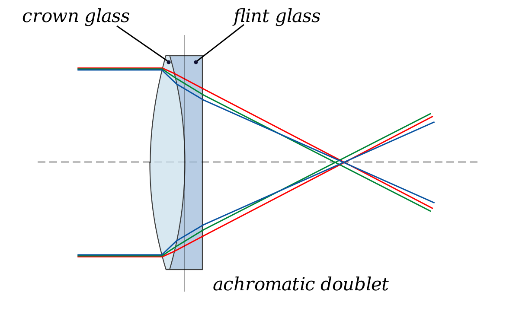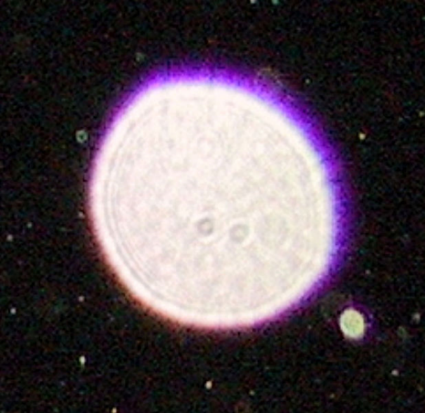There are two general classes of telescopes that are popular in the hobby market: reflectors and refractors. This article will focus on the refractors, the different types you might consider, and where they would provide the best results.
We will look at four areas that you would want to understand before purchasing. These are optics, focusers, accessories, and packaging. We will also look at how these impact pricing. And finally, I will offer some examples of each.
What is a Refractor Telescope?
Refractors are what most people think of when you say “telescope.” They are made up of a tube with a lens in the front and an eyepiece at the back.
The size of that front lens, the aperture, is usually expressed in millimeters (mm) or inches. It is convenient to know that 25.4 mm equals 1 inch. These measurements are used interchangeably, so it is best to get comfortable with the common sizes of refractors on the market.
- 50 mm is about 2 inches
- 76 mm is about 3 inches
- 102 mm is about 4 inches
- 127 mm is about 5 inches
- 150 mm is about 6 inches
- 203 mm is about 8 inches
While refractors can be smaller than 50 mm or larger than 8 inches, most will fall into the 70 mm to 150 mm range. Most of the time, the only market for refractor telescopes bigger than 8″ is the observatory market, not the hobby market.
Unlike reflectors, refractors do not have a secondary mirror in the light path, so you get the full value of the light-gathering front lens. A 100 mm refractor telescope has more effective light-gathering ability than a 100 mm reflector telescope.
Within the refractor family, we have various grades of scope, but they fall into two major categories based on the design of the objective lens: achromatic refractors and apochromatic refractors. We’ll look at both and their variations, discussing the benefits and drawbacks of each so you can decide which is best for your application.
The Refractor Design
All refractors have an objective lens upfront. At the rear, you would place an eyepiece or sensor. The objective’s purpose is to gather light and concentrate it down to the focal point and, eventually, the eyepiece where you see the image. A simple diagram is shown here.

The classic “spyglass” or binoculars have this straight-through design. The image is inverted, but a correcting prism can be inserted in the path to correct the image for terrestrial use, which is what is done with binoculars.

For astronomy, we usually add a diagonal that turns the image 90 degrees so the eyepiece is at a more comfortable viewing position. This inverts the image again so that it appears right-side up. However, it comes up reversed left and right.

Most of the time, this left-right reversal doesn’t matter for astronomy, and we don’t add a prism to fix it because it will cut down on the amount of light that gets to the eye or camera sensor.
But for daytime use of a spotting scope, we can replace the 90-degree “star diagonal” with a 45-degree “correct image” diagonal that has a correcting prism. While this does result in some light loss, it is insignificant for daytime use.
The focuser is located between the eyepiece or sensor. This moves the light train in or out to help bring the image into focus.
Chromatic Abberation
As is the case with all optical systems, they are the sum of their design compromises. With refractors, we have no obstruction in the light path, but we do have to deal with chromatic aberration that results from our bending of light to bring it to a focal point.

The original single-lens objective refractors, as popularized by Galileo in the 1600s, had a serious problem with color distortion. The objective lens tends to split the light into colors, like a prism. As the light moves down the tube, the colors don’t arrive at the focal point precisely together, and this distorts the color, causing chromatic aberration, or CA. In addition to causing color distortion, this will reduce the sharpness of the image.
To address CA, two objective lens designs have emerged: the achromatic refractor and the apochromatic refractor.
Achromatic Refractor

Entry-level and lower-cost refractor telescopes are usually of an achromatic design. You may also see these called achromats or achro refractors.
Their objective lens is based on two lens elements made of different types of glass. Because the objective lens is made up of two lenses, they may also be referred to as “doublets.”
The two lens elements are made of different types of glass, each of which bends the light in a slightly different way. A common combination would be one lens made of Crown glass and one of Flint glass.
The result is that the colors arrive at the eyepiece more closely merged than with a single lens objective, but the effect is not perfect. Image quality can be very good for most visual observing, but when viewing bright objects, such as the Moon and planets, there can be color fringing that appears in the eyepiece but is not a characteristic of the object being observed.
This CA is usually more noticeable in achromatic refractors with lower focal ratios, usually between F5 and F8. Longer focal ratio achromats, greater than F8, show less CA, but it is still there.
Many people are very tolerant of CA for visual astronomy because they know what it is, so they ignore it. Others are more sensitive to it and find it quite annoying. And, because the three colors are not precisely aligned, it can degrade the sharpness of the image.
Achromatic refractors come in a variety of aperture sizes and are extremely popular, even among experienced observers, due to their low cost and lightweight. The lightweight also allows them to be put on lighter-weight mounts, which further reduces cost. These are the reasons it tends to be the most prevalent design in the entry-level market.
However, one place where achromatic refractors do not perform well is when used for astrophotography. While we may choose to ignore the chromatic aberration, the camera cannot. This results in very pronounced color fringing around objects, as seen in the image at the right.

While you can use an achromat for astrophotography and do some cleanup of the image on the computer, if your focus is astrophotography, an achromat is not the best tool for you.
Apochromtic Refractor
To better address the CA issue, the apochromatic refractor was developed, often referred to as an “APO” for short. The apochromatic design is based on adding a third objective lens element and using more expensive and exotic glass types. It is sometimes referred to as a “triplet.” The apochromatic refractor virtually eliminates chromatic aberration.

The APO refractor is heavily favored for astrophotography. Higher-end visual observers who want to get rid of all CA from the image also like apochromatic refractors.
APO refractors are much more expensive than achromatic refractors. The three-lens objective and the special glass used add greatly to the price. They are also significantly heavier than the achromats, which means that the mounts that support them must be stronger, more robust, and more expensive.
Note that there are variations in the design. There are, for example, four-element APO refractors. These are usually very expensive and reserved for those who want the ultimate instrument.
ED Achromat – The in-between refractor
Recent improvements in the achromatic refractor design have been made based on the introduction of new forms of ED (extra-low dispersion) glass that further reduce CA over the typical Crown/Flint glass objective lens. These ED refractors, based on a two-element objective, have created a category between the APO and the achromat. You will see them referred to as ED achromats, ED APOs, or ED doublets.
From a pricing standpoint, they fall between the achromat and the APO refractors. For visual use, they are very good, with CA further reduced by 90% or more compared to the same focal ratio achromat. In fact, for visual use, they may present no perceivable CA at all. But they are not quite as free of CA as the APO designs.
For visual use, ED achromats make an excellent upgrade from entry-level achromats. And some entry-level Astro photographers have found them good enough for AP as well. The Astrophotographer can use computer tools to process the images to eliminate any small remaining CA effects.
Focusers
As part of the package, most refractors will include a focuser system. This may or may not include a diagonal.
Focusers can vary greatly in quality and flexibility. Some of the entry-level achromatic telescopes have focusers that are made of plastic, which may be adequate for lighter 1.25” eyepieces but may struggle to handle larger wide-view eyepieces or cameras. The more expensive models will have metal focusers.
Focusers are typically of two sizes, 1.25 inches or 2 inches, which refers to the diameter of the eyepieces they can use. The 2-inch focuses usually include a 1.25-inch adapter, so both sizes of eyepieces can be used.
The key benefit of a 2-inch focuser is that it can accept the larger 2-inch eyepieces that can offer wider views. There may also be benefits for astrophotography based on the type of camera and sensor size being used.
Focusers can be single-speed or dual-speed. Again, the lower-cost telescopes usually include a single-speed focuser. This allows for rapid focusing and, in most cases, is more than adequate for visual use.
Higher-priced achromats, ED Achromats, and virtually all of the APO refractors include dual-speed focusers. You have two focus knobs: one for coarse adjustment for quick focus adjustments and one for fine adjustment with a 10:1 or 11:1 reduction for easier and very precise fine focus adjustments. A dual-speed focuser can be very beneficial to both visual and AP users alike. Naturally, they are heavier and cost more, so they are not typically seen in the entry-level market.
Other Accessories
When bought as part of a package, which is typical for entry-level achromatic refractor models, the package can include a mount and tripod, some kind of finder, one to three eyepieces, and possibly other accessories. These can be very helpful to first-time telescope buyers.
Take these accessories into account, especially when comparing entry-level packages. Even if the accessories aren’t the best, they usually work well enough to get you started and can be replaced or upgraded later if you want to.
Higher-level refractors, including achromats, ED achromats, and APOs, are often sold without accessories. The idea is that the buyer is likely to already own some of these accessories and not value the ones that might be part of a package. You may be required to add such things as a mount, mounting rings, dovetails, a diagonal, a finder, and eyepieces to make the new refractor usable. When evaluating cost and value, look at what is included in the package.
Examples
Let us take a look at some examples that would be typical of each category. I have tried to keep the aperture of each example close. These are all packages that can be recommended.
The price varies greatly depending on the packaging. Also note that since the start of the pandemic, the prices of astronomy equipment have risen dramatically, with some models seeing long wait times for delivery.
Achromatic Refractor Examples
- Celestron 22150 Omni XLT AZ 102mm Refractor ($300)
This is a typical entry-level 102 mm achromatic refractor package that includes the optical tube, diagonal, finder, mount, and an eyepiece. Celestron is one of the most popular brands in the telescope market.
As a first telescope package based on the achromatic refractor design, this will allow many people to get started in astronomy. It will show CA, but at this price point, that is to be expected.
- Celestron StarSense Explorer DX 102 mm Refractor ($469)
This is another 102 mm achromatic refractor in a similar package from Celestron. However, this one adds some enhanced features and accessories. Most noteworthy, it includes software that can run on your smartphone that shows you where to point the telescope to see the target you seek. This is a highly recommended package.
ED Refractor Example
- Sky-Watcher Evostar PRO 100 mm f/9 ED APO OTA with Aluminum Case ($1250)
This is an example of the ED doublet refractor class, again from a well-respected brand. Here, the two-element objective lens is made of special glass that gets rid of almost all of the chromatic aberration that can happen in an achromatic doublet design.
Note that they use the “APO” designation in the name even though this is a doublet, two-element lens. There is no industry standard designation for APO, so they are taking some marketing liberties to suggest that their ED doublet approaches APO capability, but it does not adhere to the triplet design normally associated with APO refractors.
At almost 4X the price of the first entry-level achromat, you are paying for that front lens, the dual speed focuser and better finder, and the diagonal and mounting rings. It doesn’t come with a mount or eyepieces because it’s assumed that you’re upgrading and already have these parts. Or you are building your telescope package and prefer to select your mount and eyepieces.
APO Refractor Examples
- William Optics Fluorostar 91 FPL53 Triplet APO Refractor with 3.3″ Rack & Pinion Focuser ($2000)
This is a good example of an APO refractor that is designed and packaged primarily for the Astrophotography market. That does not mean that it cannot be used visually, with an eyepiece, for the visual observer who wants the very best image.
Not only is the lens an APO triplet, but the focuser is especially targeted to meet the needs of astrophotographers. Again, there is no mount, no eyepieces, no finder, and no diagonal. There is nothing entry-level about this one.
Summary
Refractors are extremely popular among beginners and experienced hobbyists. They have a wide range of prices. They may be part of a complete package to help beginners get off to a good start. Or, they may be sold without any accessories, so you can put together your own package using eyepieces, diagonals, and other parts you already have.
The three types commonly available are achromats, ED achromats, and apochromatic refractors. Think of them as the low, medium, and high-priced models in the market. If you are a visual observer, achromats or ED achromats may be just what you are looking for.
If you are an astrophotographer, consider the ED achromats as your entry-level models, and the APOs as the premium models for astrophotography.
